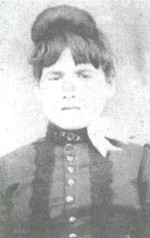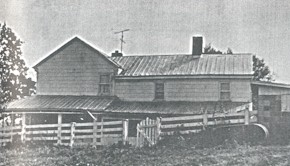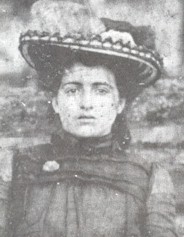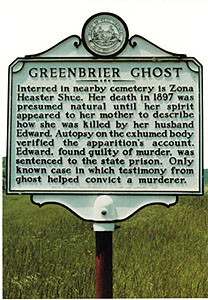
|
|||
The Greenbrier Ghost - Murder Victim Helps Convict Her Husband
By : http://listverse.com
On January 23, 1897, 23-year-old Zona Heaster Shue died under mysterious circumstances at her home in Greenbrier County, West Virginia. Strangely, by the time a doctor arrived, Zona’s husband, Erasmus “Trout” Shue, had already moved her body from the downstairs area to the bed and dressed her. Throughout the next few days, Trout displayed some bizarre behavior over his wife’s passing, but since the cause of death was initially believed to be heart failure, no one suspected foul play. However, weeks after Zona was laid to rest, her mother, Mary Jane Heaster, paid a visit the local prosecutor to ask for her daughter’s body to be exhumed. This decision was motivated by alleged visits from Zona’s ghost. Mary Jane claimed that Zona’s ghost had visited her over the course of four nights and revealed that Trout was an abusive husband who had broken her neck by strangling her in a fit of rage. The authorities agreed to Mary Jane’s request to exhume her daughter. An autopsy revealed that Zona’s neck had been broken. Trout was arrested and charged with his wife’s murder, even though the evidence against him was very circumstantial. When Mary Jane was called to the witness stand at the trial, Trout’s defense attorney challenged the story about her supposed encounters with the “Greenbrier Ghost.” However, Mary Jane never wavered from her original story, and her testimony proved to be so convincing and believable that the jury could not disregard it. In the end, they would find Trout Shue guilty. He was given a life sentence at Moundsville Penitentiary, where he died three years later. The history of the Greenbrier Ghost may be one of the most unique stories in the annals of ghostlore. This strange tale from rural West Virginia is not only a part of supernatural history, but of the history of the American judicial system as well. It remains a one of a kind event.. the only case in which the word of a ghost helped to solve a crime and convict a murderer! Elva Zona Heaster was born in Greenbrier County, West Virginia some time around 1873. Little is known about her early life or about her growing up years in the Richlands section of the county, other than she gave birth to an illegitimate child in 1895. One year later, in October 1896, she met a man named Erasmus (also called Edward) Stribbling Trout Shue. He was a drifter who moved to Greenbrier to work as a blacksmith and to start a new life for himself. He went to work in the shop of James Crookshanks, which was located just off of the old Midland Trail. All of the public roads were unpaved in those days and with the county being given over to rolling hills, it was the perfect place to find plenty of horses and cattle. A blacksmith would find plenty of work in Greenbrier County and Trout Shue did just that.  Zona became acquainted with Shue a short time after he arrived in town. The two of them were attracted to each other and soon were married, despite the animosity felt towards Shue by Zona’s mother, Mary Jane Robinson Heaster. She had taken an instant dislike to him and always felt there was something the amiable man was hiding. The two lived together as man and wife for the next several months. Then, on January 23, 1897, Zona’s body was discovered inside of her house by a young boy that Shue had sent to the house on a contrived errand. He had asked him to run to the house from the blacksmith shop and see if there was anything that Zona needed from the store. The boy, Andy Jones, found Zona lying on the floor at the bottom of the stairs. She was stretched out, with her feet together and one hand on her abdomen and the other lying next to her. Her head was turned slightly to one side. Her eyes were wide open and staring. Even to this small boy, Zona Shue was obviously dead. Andy, not surprisingly, ran home to tell his mother. The local doctor and coroner, Dr. George W. Knapp, was summoned to the house, although he didn’t arrive for nearly an hour. By this time, Shue had carried his wife’s body upstairs and had laid her out on the bed. Contrary to local custom, he dressed the corpse himself. Normally, it was the proper thing for ladies of the community to wash and dress a body in preparation for burial. However, Shue took it upon himself to dress Zona in her best clothing. A high-necked, stiff-collared dress covered her neck and a veil had been placed over her face. While Dr. Knapp examined her and tried to determine a cause of death, Shue stayed by his wife’s side, cradling her head and sobbing. Because of Shue’s obvious grief, Knapp gave the body only a cursory examination, although he did notice some bruising on her neck. When he tried to look closer, Shue reacted so violently that the physician ended the examination and he left. Initially, he listed her cause of death as "everlasting faint" and then as "childbirth". It is unknown whether Zona was pregnant or not, but for two weeks prior to her death, Knapp had been treating her for "female trouble". 
The House Where Zona was Killed
Needless to say, people started to talk. There was one person who did not have to be convinced any further that Shue was acting suspiciously about Zona’s death. This person was Mary Jane Heaster. She hated Shue from the start and had never wanted her daughter to marry the stranger. She was even more against the marriage when Zona revealed to her that Shue had been married two times before! There was something wrong in all of this, she knew, but there seemed to be no way to prove it. After the wake, Mary Jane took the sheet from inside of the coffin and later tried to return it to Shue, but he refused it. Folding it back up to put it away, she noticed that it had a peculiar odor, so she washed it out. When she dropped the sheet into a basin, the water inside turned red. Strangely, the sheet then turned pink and the color in the water vanished. Mary Jane then boiled the sheet and hung it outside for several days but the stain could not be removed. She interpreted the eerie “bloodstains” as a sign that Zona had been murdered. That was when she began to pray. Every night for the next four weeks, Mary Jane prayed fervently that her daughter would return to her and reveal the truth about how she had died. According to legend, a few weeks later, her prayers were answered.  Mary Jane Heaster Over the course of four dark nights, the spirit of Zona Shue appeared at her mother’s bedside. She would come as a bright light at first and then the apparition would take form, chilling the air in the entire room. She would awaken her mother from her sleep and explain over and over again how her husband had murdered her. Trout Shue had been abusive and cruel, she said and had attacked her in a fit of rage because he thought she had not cooked any meat for supper. He had then savagely broken her neck and to show this, the ghost turned her head completely around until she was facing backwards. Mary Jane had been right. Shue had killed her daughter and the word of her spirit proved it! A short time later, Mary Jane went to the local prosecutor, John Alfred Preston, so that she could convince him to re-open the investigation into Zona’s death. She offered the visitations from her daughter’s spirit as evidence that a miscarriage of justice was taking place. By all accounts, Preston was both polite and sympathetic to Mrs. Heaster. The two of them spoke together for "several hours" and at the end of the meeting, Preston agreed to dispatch deputies to speak with Dr. Knapp and a few others involved in the case. While it seems unlikely that he was willing to take another look at the case because of the statement of a ghost, the investigation did get re-opened. Local newspapers reported that Mrs. Heaster was not the only one in the community who was suspicious about Zona’s death. There were also "certain citizens" who had started to ask questions, as well as the growing "rumors in the community". Preston himself went out to Richlands to see Dr. Knapp, who admitted that his examination of the dead woman had been incomplete. The two of them agreed that an autopsy would clear things up and would confirm or deny the lingering suspicions. It would also give them a better idea of how Zona Shue died and lift suspicions from Trout, if indeed he was innocent. Days later, an exhumation was ordered and an inquest jury was assembled. The autopsy was performed in the Nickell School House, which was just a short distance away from the Soule Methodist Church graveyard. The schoolchildren were dismissed on the day of February 22, 1897, when the body of Zona Shue was exhumed. It was reported in the local newspaper that Trout Shue "vigorously complained" about the exhumation but it was made clear to him that he would be forced to attend the inquest if he did not go willing. In rebuttal he replied that he knew that he would be arrested, "but they will not be able to prove I did it". This careless statement indicated that he at least had knowledge that his wife had been murdered. The autopsy lasted for three hours with the doctors working under the uncertain light of kerosene lanterns. The body of the dead woman was "in a near state of perfect preservation" though, thanks to the cold temperatures of February, making their work that much easier. A jury of five men had been assembled to watch the proceedings and they huddled together in the barely warm building with officers of the court, Trout Shue, Andy Jones (the boy who had found the body) and other witnesses and spectators. The autopsy was carried out by the standard methods, which meant that an examination of the vital organs came first. After that, the doctors cut an incision along the back of the skull so that the brain could be removed. This step was not taken in the case of Zona Shue however, as the doctors quickly found what they were looking for. "We have found your wife’s neck to have been broken," one of the physicians spoke to Trout Shue. His head dropped and an expression of despair crossed over his face. "They cannot prove that I did it," he whispered. It may seem odd that the broken neck was not found immediately and or that it was not more evident on the skin’s surface, but doctors will tell you that this is one of the most difficult injuries to detect. It makes it harder to tell in a corpse because the human head is naturally heavy in comparison to the body. When the muscles of the dead person are relaxed, the head tends to flop about. In addition, the first vertebra is located deep inside of the neck, directly under the skull. This makes it hard to find and it would have been that much harder for rural physicians in the late 1800’s. The autopsy findings were quite damning to Shue. A report on March 9 said that "the discovery was made that the neck was broken and the windpipe mashed. On the throat were the marks of fingers indicating that she had been choken [sic]..... the neck was dislocated between the first and second vertebrae. The ligaments were torn and ruptured. The windpipe had been crushed at a point in front of the neck." The findings were made public at once, upsetting many in the community. Shue was arrested and charged with murder. He was locked up in small stone jail on Washington Street in Lewisburg. Despite the fact that (outside of spirit communications) the evidence against Shue was circumstantial at best, he was indicted by a grand jury and was formally arraigned for murder. He immediately entered a plea of "not guilty". While he awaited trial, information about Shue’s unsavory past began to surface, leading many to believe that Mary Jane Heaster had been right about him all along. Zona had been his third wife. His first marriage, to Allie Estelline Cutlip, had produced one child but had ended in divorce in 1889 while Shue was in prison for horse stealing. She alleged in the divorce decree that her husband had frequently beaten her. In 1894, Shue had married again, this time to Lucy Ann Tritt. Strangely, Lucy died just eight months later under circumstances that were described as "mysterious". Shue claimed that Lucy had fallen and had hit her head on a rock, but few believed him. Wisely, he packed up and left the area and in the autumn of 1896, moved to Greenbrier. In jail, Shue remained in good spirits, and reported that his grieving for Zona had ended. In fact, he announced that he had a lifelong goal of having seven wives. Since Zona had only been his third, and he was still a young man, he had a good chance of realizing such a worthwhile ambition. He repeatedly told reporters that his guilt in the matter could not be proved. The trial began on June 22, 1897 and numerous people from the community testified against Shue. The highlight of the trial, of course, came with the appearance of Mary Jane Heaster. Preston put her on the stand both as the mother of the dead woman and also as the first person to notice the unusual circumstances of her death. He wanted to make sure that she appeared both sane and reliable. For this reason, he skirted the issue of the ghost story because it was bound to make her appear irrational and also because it was inadmissible evidence. The teller of the story, in this case Zona Shue, could obviously not be cross-examined by the defense and so her testimony would be hearsay under the law. Unfortunately for Shue, his attorney decided to ask Mrs. Heaster about her ghostly sighting. It seemed obvious that he was doing it to try and make Mary Jane look ridiculous to the jury. He characterized her "visions" as a mother’s ravings and worked hard to admit that she might have been mistaken about what she allegedly saw. He continued to badger her for quite some time, but Mary Jane never wavered from what she had seen. When the defense counsel realized that the testimony was not going the way that he wanted, he dismissed her. By that time though, the damage was done. Because the defense and not the prosecution had introduced the testimony about the ghost, the judge had a hard time telling the jury to exclude it. It was apparent that most of the people in the community believed that Mary Jane had seen her daughter’s ghost. Despite Shue’s eloquent testimony in his own defense, the jury quickly found him guilty. Ten of them even voted that he be hanged, which spoke volumes about Mrs. Heaster’s believability as a witness. Without a unanimous verdict of death though, Shue was sentenced to life in prison. The sentence did not satisfy everyone in Greenbrier County. On July 11, 1897, a citizen’s group of anywhere from fifteen to thirty men assembled eight miles west of Lewisburg to form a lynching party. They had purchased a new rope and were well armed with "Winchesters and revolvers" when they started towards the jail. If not for a man named George M. Harrah, who contacted the sheriff, Shue would have surely have been lynched. Harrah contacted Deputy Sheriff Dwyer at the jail. It was said that when Shue was informed of this threat against his life, he became "greatly agitated" and was unable to tie his own shoes. Dwyer took him to a "place of refuge in the woods" a mile or so from town and then was able to disband the mob and return them to their homes. Shue was moved to the West Virginia State Penitentiary in Moundsville on July 14, where he lived for the next three years. He died on March 13, 1900 from one of the epidemics of measles, mumps or pnuemonia that swept through the prison that spring. At that time, the prison commonly buried unclaimed remains in the nearby Tom’s Run Cemetery, for which no records were kept until the 1930’s. No trace of Trout Shue can be found today. Mary Jane Robinson Heaster lived to tell her tale to all who would listen. She died in September 1916 without ever recanting her story about her daughter’s ghost. And as for Zona, her ghost was never seen again, but she has left a haunting and a historical mark on Greenbrier County. It is one that is still being felt today. In fact, a roadside marker along Route 60 still commemorates the case today. It reads: Interred in nearby cemetery is Zona Heaster Shue. Her death in 1897 was presumed natural until her spirit appeared to her mother to describe how she was killed by her husband Edward. Autopsy on the exhumed body verified the apparition’s account. Edward, found guilty of murder, was sentenced to the state prison. Only known case in which testimony from ghost helped convict a murderer. comments powered by Disqus Submit News/Videos/Links | Discuss article | http://listverse.com | More Unsolved and Unexplained Mysteries |
More can be addded on request. Direct your requests at vinit@theunexplainedmysteries.com
